-
1 of 253523 objects
Dorothea Jordan, nee Bland (1761-1816) and two of her children 1831-34
Marble | 137.2 x 68.60 x 94.0 cm; 95000 g (Weight) (whole object) | RCIN 2177
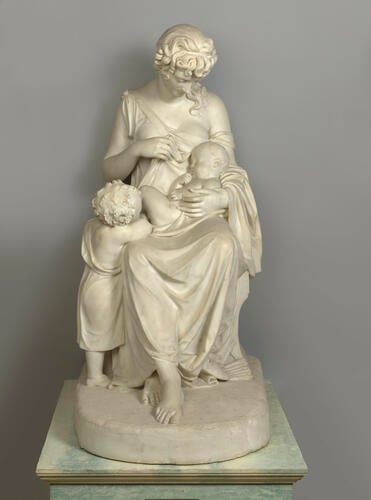
Sir Francis Chantrey (1781-1841)
Mrs. Jordan, née Dorothea Bland (1761-1816) and two of her children 1831-34
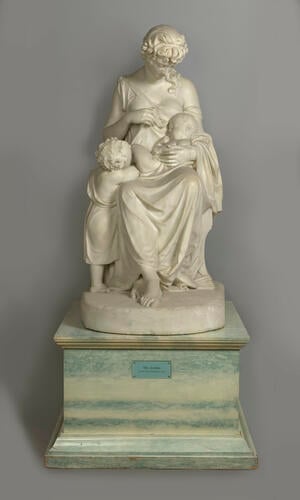
Sir Francis Chantrey (1781-1841)
Mrs. Jordan, née Dorothea Bland (1761-1816) and two of her children 1831-34
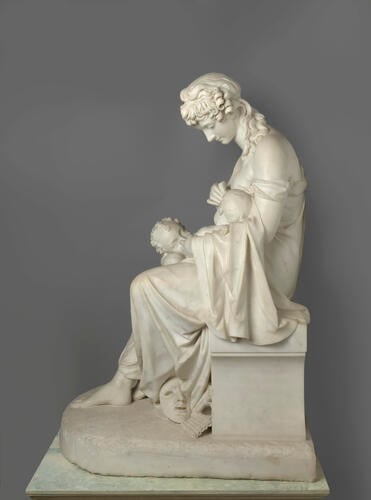
Sir Francis Chantrey (1781-1841)
Mrs. Jordan, née Dorothea Bland (1761-1816) and two of her children 1831-34
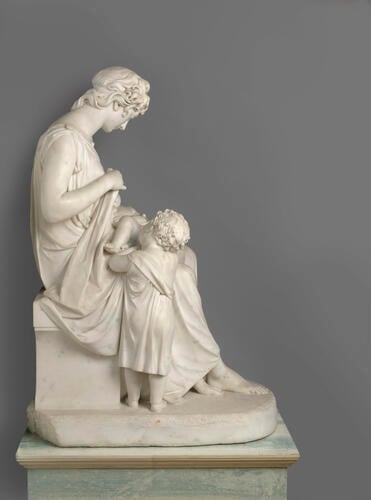
Sir Francis Chantrey (1781-1841)
Mrs. Jordan, née Dorothea Bland (1761-1816) and two of her children 1831-34
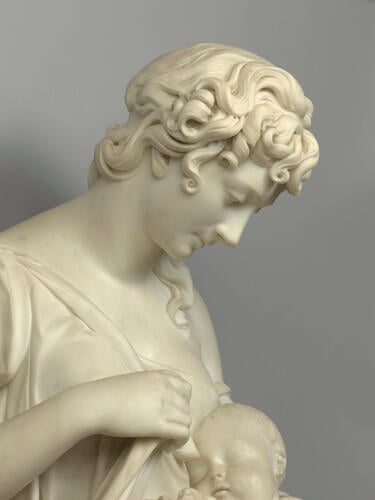
Sir Francis Chantrey (1781-1841)
Mrs. Jordan, née Dorothea Bland (1761-1816) and two of her children 1831-34
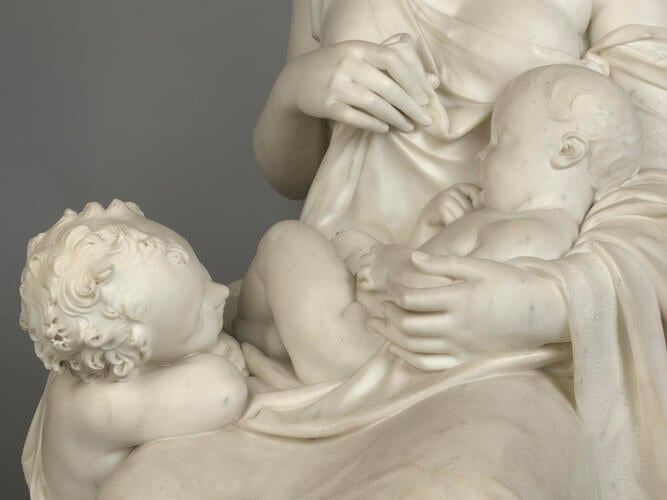
Sir Francis Chantrey (1781-1841)
Mrs. Jordan, née Dorothea Bland (1761-1816) and two of her children 1831-34
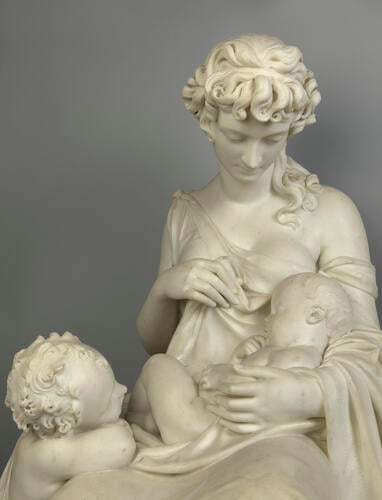
Sir Francis Chantrey (1781-1841)
Mrs. Jordan, née Dorothea Bland (1761-1816) and two of her children 1831-34







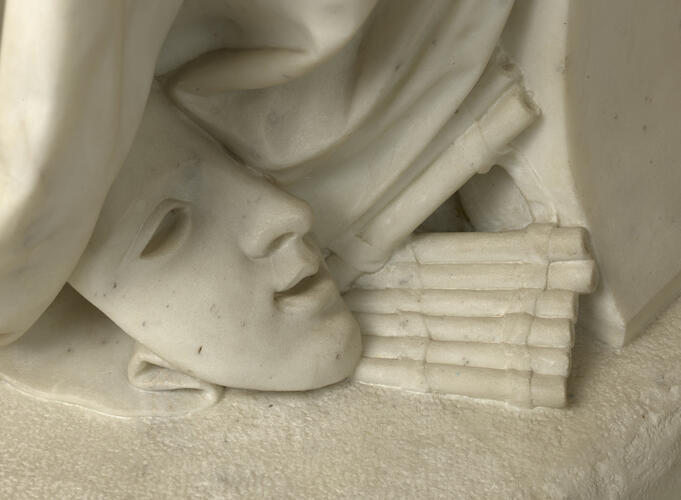
-
A life-size white marble figural group of Mrs. Jordan, seated, carved in the round, her head inclined and to the sitter's left to look down at the sleeping infant in her left arm. The hair is vigorously carved in loose spirals retained by a band towards the front of the head, and spilling forward over the sitter's left shoulder; with her right arm bent at the elbow she holds with separated fingers the edge of a cloth on which a young infant is sleeping in her lap, its body supported by her left forearm and hand. The cloth, with an embroidered edge, passes over her left forearm and falls by her side, slightly overlapping the back of the throne0like chair with incurved sides on which she is seated. A second, older child stands by the sitter's right leg and rests his right elbow on her knee, also looking towards the sleeping infant. A mask of comedy and a set of panpipes lean against the throne. The sitter's bare feet rest on the punched surface of the otherwise uncharacterised base, curved at the front and straight at the back. The back corners of the plinth have been cut away, possibly at a later date. The whole later placed on a rectangular green marble plinth.
Dorothea, or Dora, Jordan, was born in London, one of perhaps nine children of Francis Bland, heir to the Derriquin estate in County Kerry, and Grace Phillips, an actress. In 1774 Bland, who had been disinherited on account of this liaison, made a legal marriage in London and left his first family in ireland where Grace raised them on an allowance from the Blands, granted on the condition that the children did not use their father's name. In 1779 Dorothea made her debut at the Smock Alley Theatre in Dublin where she had travelled with her mother, becoming the mistress of the company manager Edward Daly and fleeing to England after a few years, pregnant and heavily in debt. By 1785 she was in London and employed in Sheridan's Theatre Royal, Drury Lane.
In London she lived with Richard Ford (1758-1806), a major shareholder in the Theatre Royal, with whom she had five children. By the 1790s she had become the most celebrated comic actress in London, for roles including Viola in Twelfth Night, Rosalind in As You Like It, Restoration comedies and contemporary works, notably those by Sheridan. She broke with Ford and became the mistress of the Duke of Clarence, later William IV, around 1791. They lived together effectively as man and wife for twenty years until 1811, when the duke dismissed the mother of his ten children in order to marry and provide legitimate heits to the throne. Dorothea died in poverty in France in 1816.
This commission was one of William's first acts as king, George Jones describing how he wept as he told Chantrey of Dorothea's character, asking him to emphasize the quality of 'maternal affection' in the design of the monument. As a result the group recalls allegories of maternal love, Charity, and the Madonna and Child with St John. Chanrety had already made several seated female monuments. The sitter made use of some of the quantity of painted portraits of Dorothea, perhaps especially Romney's 1787 full length.
Text adapted from Sculpture in the Collection of His Majesty The King (2025).Provenance
Commissioned by William IV in 1831 and completed in 1834, intended to be placed in Westminster Abbey but prevented by the Dean, John Ireland. A later account of the work between Lord Melbourne and Queen Victoria suggested that it was intended for the Henry VII Chapel, which as Crown property should not have been prevented, but that the Earl of Munster, the sitter's eldest son, provaricated with the king and the installation never happened. Its shape suggests that it was designed to be free of a wall. In the sculptors' studio at his death, 1841.
Installed at St Margaret, Mapledurham, Oxfordshire, by the sitter's youngest child Rev. Lord Augustus Fitzclarence.
Removed during alterations to the church, 1863.
At Penshurst Place, Kent, until 1908, when moved to the London residence of the fourth Earl of Munster.
At Sandhills Court, Surrey.
Exhibited at the Royal Academy, 1956.
Bequeathed to Queen Elizabeth II by the 5th Earl of Munster (great, great, great grandchild of the sitter), 1975 and moved to Buckingham Palace on the death of his widow, 1980, and installed in the Picture Gallery, Buckingham Palace.
The sawn-off head of the full-size plaster model and a preliminary clay model are in the collection of the Ashmolean Museum, Oxford.
The front of the original plinth is at Penshurst Place. -
Creator(s)
(nationality) -
Medium and techniques
Marble
Measurements
137.2 x 68.60 x 94.0 cm; 95000 g (Weight) (whole object)
Place of Production
London [Greater London]